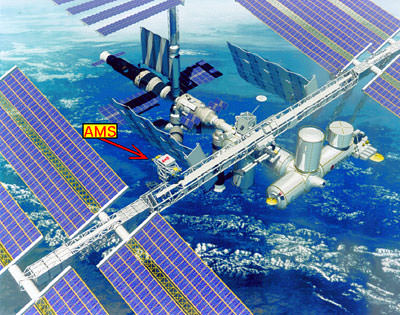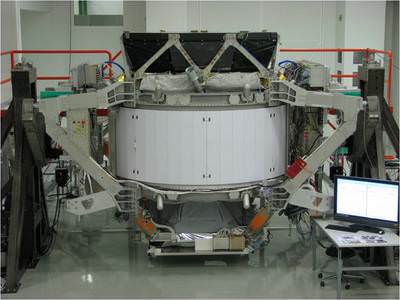[/caption]
The long-awaited experiment that will search for dark matter is getting closer to heading to the International Space Station. The Alpha Magnetic Spectrometer (AMS) is undergoing final testing at ESA’s Test Centre in the Netherlands before being launched on the space shuttle to the ISS, currently scheduled for July, 2010. The AMS will help scientists better understand the fundamental issues on the origin and structure of the Universe by observing dark matter, missing matter and antimatter. As a byproduct, AMS will gather other information from cosmic radiation sources such as stars and galaxies millions of light years from our home galaxy.
ISS officials have been touting that science is now beginning to be done in earnest on the orbiting laboratory. The AMS will be a giant leap in science capability for the ISS. Not only is it the biggest scientific instrument to be installed on the International Space Station (ISS), but also it is the first magnetic spectrometer to be flown in space, and the largest cryogenically cooled superconducting magnet ever used in space. It will be installed on the central truss of the ISS.

AMS had been cut from the ISS program following the 2003 Columbia shuttle accident, but the outcry over the cancellation forced NASA to rethink their decision. Most of AMS’s $1.5-billion costs have been picked up the international partners that NASA wishes to stay on good terms with. 56 institutes from 16 countries have contributed to the AMS project, with Nobel laureate Samuel Ting coordinating the effort.
In an interview with the BBC, Ting said results from AMS may take up to three years to search for antimatter in other galaxies, and dark matter in our own.
The instrument was built at the European Organization for Nuclear Research (CERN) in Geneva, Switzerland. The first part of the tests was also conducted at CERN, when the detector was put through its paces using a proton beam from CERN’s Super Proton Synchrotron accelerator to check its momentum resolution and its ability to measure particle curvature and momentum.
AMS’s ability to distinguish electrons from protons was also tested. This is very important for the measurement of cosmic rays, 90% of which are protons and constitute a natural background for other signals that interest scientists. AMS will be looking for an abundance of positrons and electrons from space, one of the possible markers for dark matter.
Once the extensive testing is complete, AMS will leave ESTEC at the end of May on a special US Air Force flight to Kennedy Space Center in Florida. It will be launched to the ISS on the Space Shuttle Endeavour on flight STS-134, now scheduled for July.
Source: ESA


Sometimes I think my ‘old lady’ is a Strangelet! Because sometimes when she’s with a ‘gaggle’ of her girlfriends, they all become rather ‘Strange’, and THAT can turn into a DARK MATTER! ~@; )
Minor niggle.. ” but also it is the first magnetic spectrometer to be flown in space,” actually AMS-1 flew on STS-91 in 1998.
It’s very cool that it is going to fly.
Wasnt this supposed to be the very last shuttle mission?
*Sads* What a lot of money spent on a purely theoretical concept having no evidence…dark matter is just an ad hoc prop to hold up a theory. Even its proponents admit that on occasion.
Elf4God
I agree, dark matter/energy is probably a manifestation of space fabric itself but let’s see if we are proved wrong, after all, still no gravity waves detected nor proton decay.
I don’t think the AMS will test for dark energy. Instead it is meant to determine the masses of particles which interact with the supercool system. It might pick up a dark matter (DM) particle or two. So far the Cryogenic Dark Matter Search has found only hints of dark matter, so the AMS may get a few DM hits as well. The question is whether this will improve the statistics in the data base sufficiently to make any conclusion on DM.
I suspect that DM consists largely of neutralinos, which is a mixed eigenstate of the supersymmetric pairs of the photon, Higgs and Z particle. These all have the same quantum numbers, so are expected to exist in this mixed state. The stranglet state is an oddball. The conversion of a quark to the strange quark in a baryon transitions a neutron to a lower energy state, and similarly a proton with a weak process in addition. So we might expect there to be strangelet particles, and indeed we might think that neutron star cores would convert into strangelet states as well. Yet so far there is no evidence of these. At sufficiently high energy we might expect there to be strangelet production that is fairly copious, but so far — nada.
I think the reason strangelets either don’t exist or are rare is they involve some aspect of weak interactions or weak-like interactions. This might be obstructed by something called the axion, which is a light particle-field which gives strong interactions CP physics similar to weak interactions.
LC
Whatever dark matter is made of… it has to be made of something which has MASS, since its gravitational affects is the evidence used to thorize its existence.
Massless particles zooming around space is nearly infinite and hardly unique in the universe. There is a very complicated term used to describe it: RADIATION
You can’t understand theories as having ad hocs.
First, that these things are related by theory falsifies that they are isolated hypotheses (“ad hocs”).
Second, these things are predictions from a theory which test it together with its other predictions, again falsifying the prediction that they are in any way isolated.
In this case AFAIU all the simple alternatives have been falsified, leaving very construed rivals. Also, each instance of test (“Bullet cluster”, et cetera) is, or so I have been told on an astrophysicist blog, individually specific.
Which goes back to “gap ideas” of diverse believers – their gaps are always “just so”, and especially here.
“all the simple alternatives” – to DM, of course.
Searching for DM may by folly, but experiments to prove that must be conducted. A lot of people thought evolution was folly too, but Darwin et.al. pursued it anyway.